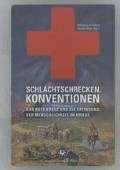Abstract
The origins of the Red Cross Movement and of the modern international humanitarian law are closely connected to the conclusions of Henry Dunant’s famous book, Un Souvenir de Solférino, edited in 1862. After his traumatic experience among the wounded soldiers abandoned on the battlefield, Dunant suggested that voluntary relief societies should be established to care for the injured people in military operations. Furthermore, he proposed that an international principle be created to serve as the basis for these charitable societies. The success of this work was immediate and gave rise to concrete realisations. New legal regulations were elaborated, discussed in Geneva during two international conferences in 1863 and 18642 and then internationally adopted to limit the impetuousness and the deadly cleverness of the belligerents. A worldwide network of national relief societies was also progressively established under the emblem of the Red Cross in order to bring assistance to the wounded soldiers in wartime. In this double process of humanization of war, the International Committee of the Red Cross (ICRC) played an essential role, and became the mainspring of this new «military philanthropy».
Post tenebras lux is the official motio of the Canton and Republic of Geneva. The author warmly thanks Irène Herrmann and Fabrizio Bensi for their judicious remarks and comments.
Preview
Unable to display preview. Download preview PDF.
Notes
For some historical examples, see Boissier, Pierre: History of the International Committee of the Red Cross. From Solferino to Tsushima. Geneva 1985 (for the English version; first edition 1963), p. 125–139.
Holmes, Richard (dir.). Atlas historique de la Guerre. Les armes et les batailles qui ont changé le cours de l’histoire. Paris 1991, p. 108–110.
Habermas, Jürgen: The Structural Transformation of Public Sphere: An Inquiry into a category of Bourgeois Society. Cambridge 1989 (for the English translation). This book was first published in German, in 1962.
As for some others iconic figures of the humanitarianism, most of the books dedicated to the founders of the ICRC are hagiographic ones; see for instance, de Senarclens, Jean: Gustave Moynier le bâtisseur. Geneva 2000.
Numerous books or studies have been written about the life of Henry Dunant. For a general overview, see Durand, Roger (ed.). De l’utopie à la réalité. Actes du colloque Henry Dunant. Genève 1988.
Mützenberg, Gabriel: Henry Dunant le prédestiné XX: du nouveau sur la famille, la jeunesse, la destinée spirituelle du fondateur de la Croix-Rouge. Genève 1984.
Ferdinando Palasciano (1815–1891) was an Italian surgeon who had the first called for the neutralization of the wounded soldiers; De Luca Camillo; Palasciano, Guiseppe: Ferdinando Palasciano. Il precursore della Croce Rossa. Fasano 1992.
Anatoly Nicolalevitch Demidov (1813–1870) started an international committee to aid prisoners of war of the Crimean War, see Meurant, Jacques. Anatole Demidoff pionner de l’assistance aux prisonniers de guerre. Préludes et pionniers. Les précurseurs de la Croix-rouge, 1840–1860. (Collection Henry Dunant n° 5), Geneva 1991, p. 95–117.
Lubin, Georges: Henry Arrault, une priorité disputée ou la guerre des deux Henry. In: Durand, Roger; Meurant, Jacques (eds.): Préludes et pionniers. Les précurseurs de la Croix-rouge, 1840–1860. (Collection Henry Dunant n° 5), Geneva 1991, p. 211–223.
Langendorf, Jean-Jacques. Guillaume Henri Dufour ou la passion du juste milieu. (Collection Les Grands Suisses n°1). Lausanne, Lucerne 1987.
Remak, Joachim: A Very Civil War: The Swiss Sonderbund War of 1847. Boulder; San Francisco [etc.] 1993.
Herrmann, Irène: Les cicatrices du passé. Essai sur la gestion des conflits en Suisse (1798–1918). Bern 2006.
Violette, Jean. La révolution de 46. Genève 1945; Ruchon, François. La révolution de 1846 vue par les contemporains. Genève 1945.
Herrmann, Irène. Genève entre canton et république: les vicissitudes d’une intégration nationale (1814–1846). Genève, Québec 2003.
Author information
Authors and Affiliations
Editor information
Rights and permissions
Copyright information
© 2011 Centaurus Verlag & Media UG
About this chapter
Cite this chapter
Palmieri, D. (2011). Post tenebras lux: New perspectives on the foundation of the Red Cross. In: Eckart, W.U., Osten, P. (eds) Schlachtschrecken — Konventionen. Neuere Medizin- und Wissenschaftsgeschichte, vol 20. Centaurus Verlag & Media, Herbolzheim. https://doi.org/10.1007/978-3-86226-459-9_2
Download citation
DOI: https://doi.org/10.1007/978-3-86226-459-9_2
Publisher Name: Centaurus Verlag & Media, Herbolzheim
Print ISBN: 978-3-86226-045-4
Online ISBN: 978-3-86226-459-9
eBook Packages: Humanities, Social Science (German Language)

